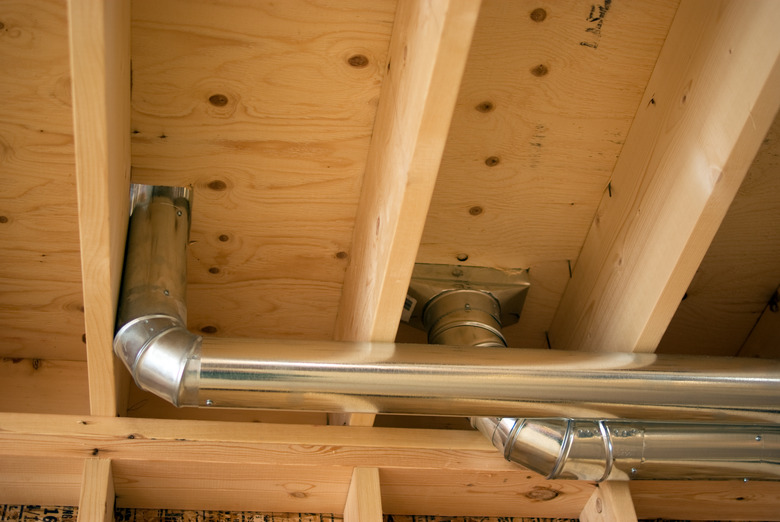How To Transition From A Round Duct To Rectangular
We may receive a commission on purchases made from links.
The easiest way to transition from round duct to rectangular is to install a transition section. Generally, you want the total venting area of the rectangular section to be the same as that of the round section, but you shouldn't have to worry about this when using store-bought transition sections because the manufacturer has already made that calculation. Sometimes, however, you have to make the calculations yourself when transitioning to a rectangular section with odd dimensions needed to fit into a tight space.
You might occasionally come across a situation in which the area of the rectangular section is smaller than that of the round one or vice versa. This could happen when you're installing a branch line for a vent in a tight space or around an obstruction. You can make this transition with a section of duct called a takeoff.
Calculating Venting Area
Calculating Venting Area
You need a little math to calculate venting areas. The area of a rectangle is the width (W) of the rectangle multiplied by the length (L), while that for a round duct is πD2/4, where D is the diameter of the duct. When transitioning from a rectangular duct, there's only one size of round duct you can use, but when transitioning from round ductwork, there are many possibilities for the rectangular section.
For instance, 6-inch round duct has a venting area of roughly 28 square inches. Rectangular duct with the same venting area could be 7 x 4 inches, 6 x 4.5 inches or — if you need square duct — 5.2 x 5.2 inches. Commercially available transition sections are already premeasured, so you shouldn't have to make these calculations unless you're custom-forming your own ducts.
Installing a Transition Section
Installing a Transition Section
Installing a transition section isn't much different than installing any other ductwork fitting. Ducts have male and female ends, and in most cases, you simply push the male and female ends together and secure the ducts with self-tapping screws or aluminum tape. If you have to cut a section of duct to make room for the fitting, you'll have to butt the fitting to the pipe. In that case, use a draw band connector to hold the fitting to the pipe and reinforce the joint with aluminum tape to prevent leaks.
If you don't have a draw band connector, you can make your own by cutting a 4-inch section from a length of round or rectangular duct as needed and making one cut that allows you to separate it and fit it over the connection. Secure this makeshift connector to the ducts with self-tapping screws and tape the joint to make it leakproof.
Using Ductwork Takeoffs
Using Ductwork Takeoffs
Takeoffs are ductwork fittings that allow you to transition to a duct with a smaller venting area. One end of the fitting has a series of tabs that bend around the inside of the duct from which you're transitioning, or it has a flange that can be screwed to the outside of the duct. To install a round takeoff on rectangular duct, start by drawing the outline of the takeoff and cutting a hole with tin snips or a hole cutter. Install the takeoff by inserting the tabs and bending them to hold the fitting in place, or if you have a takeoff with a flange, by screwing the flange to the duct with self-tapping screws.
Installing a rectangular takeoff on a round duct isn't as common, but if this is necessary, you need a takeoff with a rounded flange that will fit snugly on the duct. Most of these types of takeoffs are round-to-round, but you can modify one to fit rectangular duct by adding a transition section.
